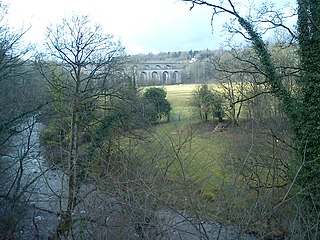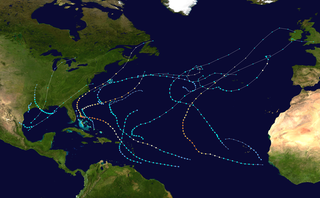Dorsum Niggli is a wrinkle ridge at 29°00′N52°00′W / 29.0°N 52.0°W in Oceanus Procellarum on the Moon. It is 50 km long and was named after Paul Niggli in 1976.
Dorsum Niggli is a wrinkle ridge at 29°00′N52°00′W / 29.0°N 52.0°W in Oceanus Procellarum on the Moon. It is 50 km long and was named after Paul Niggli in 1976.

The Arctic Archipelago, also known as the Canadian Arctic Archipelago, is an archipelago lying to the north of the Canadian continental mainland, excluding Greenland and Iceland.

Delta County is a county located in the U.S. state of Colorado. As of the 2020 census, the population was 31,196. The county seat is Delta.

Saint Tudwal's Islands are a small archipelago lying south of Abersoch on the Llŷn Peninsula in North Wales, at the western end of Tremadog Bay. They were referred to as the Studwells in the early 19th century. The name of the islands derives from their traditional identification as the site of a hermitage used by Saint Tudwal during the 6th century. They are about 1 kilometre (0.6 mi) east of the southern tip of the Llŷn Peninsula.

In geology, hotspots are volcanic locales thought to be fed by underlying mantle that is anomalously hot compared with the surrounding mantle. Examples include the Hawaii, Iceland, and Yellowstone hotspots. A hotspot's position on the Earth's surface is independent of tectonic plate boundaries, and so hotspots may create a chain of volcanoes as the plates move above them.
The ceremonial county of Lincolnshire is the second largest of the English counties and one that is predominantly agricultural in character. Despite its relatively large physical area, it has a comparatively small population. The unusually low population density that arises gives the county a very different character from the much more densely populated and urbanised counties of south-east and northern England, and is, in many ways, key to understanding the nature of the county.

Montes Agricola is an elongated range of mountains near the eastern edge of the central Oceanus Procellarum lunar mare. It lies just to the northwest of a plateau containing the craters Herodotus and Aristarchus.

Paul Niggli was a Swiss crystallographer, mineralogist, and petrologist who was a leader in the field of X-ray crystallography.
Wood End may refer to:


Point Buchon State Marine Reserve (SMR) and Point Buchon State Marine Conservation Area (SMCA) are two adjoining marine protected areas that lie offshore Point Buchon in San Luis Obispo County on California's central coast. The combined area of these piip marine protected areas is 18.21 square miles (47.2 km2). The SMR protects all marine life within its boundaries. Fishing and take of any living marine resources is prohibited. Within the SMCA fishing and take of all living marine resources is prohibited except the commercial and recreational take of salmon and albacore.

The 2000 Atlantic hurricane season was an event in the annual tropical cyclone season in the north Atlantic Ocean. There was above-normal activity during the season, with nearly all its activity occurring during a three-month period, August–October. The season officially began on June 1, 2000 and ended on November 30, 2000. These dates, adopted by convention, historically describe the period in each year when most tropical systems form. Although two tropical depressions formed in June, the first named storm, Alberto, did not arise until August 4. The season's final storm, an unnamed subtropical storm, became extratropical on October 29.
Church End is the name of several ancient hamlets located in Bedfordshire:
Josefina Niggli was a Mexican-born Anglo-American playwright and novelist. Writing about Mexican-American issues in the middle years of the century, before the rise of the Chicano movement, she was the first and, for a time, the only Mexican American writing in English on Mexican themes; her egalitarian views of gender, race and ethnicity were progressive for their time and helped lay the groundwork for such later Chicana feminists as Gloria Anzaldúa, Ana Castillo and Sandra Cisneros. Niggli is now recognized as "a literary voice from the middle ground between Mexican and Anglo heritage." Critic Elizabeth Coonrod Martinez has written that Niggli should be considered on a par with such widely praised Spanish-language contemporaries as Mariano Azuela, Martín Luis Guzmán and Nellie Campobello. She is thought to be the only Mexican-American woman to have a theatre named after her, the Niggli Studio Theater at Western Carolina University.

The River Ceiriog is an 18 miles (29 km) long river in north east Wales, whose name may derive from a term meaning "favoured one". It is a tributary of the River Dee. It rises at an altitude of around 1,800 ft (549 m) on the south east slopes of Moel Fferna in the Berwyn Mountains, and flows through the Ceiriog Valley in Wrexham County Borough. It flows below Chirk Castle and the town of Chirk, where the Chirk Aqueduct carries the Llangollen Canal, and the Chirk Viaduct carries the Shrewsbury–Chester line over the river. The Ceiriog joins the Dee east of the town. In its lower reaches, the river forms the border between Wales and Shropshire in England. Home to a trout fishing club, the river and its valley were described by British prime minister David Lloyd George as "a little bit of heaven on earth". As well as being a home to trout, the first grayling to be artificially reared in Wales were released into the river in 2009.

The 2017 Atlantic hurricane season was an event in the annual tropical cyclone season in the north Atlantic Ocean. This Atlantic hurricane season saw above-normal activity; it was the seventh most active season on record and the most active since 2005. The season officially began on June 1, 2017 and ended on November 30, 2017. These dates, adopted by convention, historically describe the period in each year when most tropical systems form. However, storm formation is possible at any time of the year, as demonstrated in 2017 by the formation of the season's first named storm, Tropical Storm Arlene, on April 19. The final storm of the season, Tropical Storm Rina degenerated to a remnant area of low pressure on November 9.

The 2018 Atlantic hurricane season was an event in the annual hurricane season in the north Atlantic Ocean. It as an above-average season for tropical cyclones for the third consecutive year. Though the season officially began on June 1, 2018 and ended November 30, 2018, dates adopted by convention and historically describe the period during each year when most tropical cyclones form, it effectively started with the formation of Tropical Storm Alberto on May 25. The season's final storm, Hurricane Oscar, dissipated on October 31.

The 2018 Pacific hurricane season was an event in the annual cycle of tropical cyclone formation, in which tropical cyclones form in the eastern Pacific Ocean. The season officially started on May 15 in the eastern Pacific—east of 140°W—and began on June 1 in the central Pacific—the region between the International Date Line and 140°W, and ended on November 30. These dates typically cover the period of each year when most tropical cyclones form in the eastern Pacific basin. The season began with the formation of Tropical Depression One-E, which developed on May 10, and ended with the dissipation of the season's final storm, Tropical Storm Xavier, which dissipated as a tropical cyclone on November 5.

The 2019 Atlantic hurricane season was an event in the annual tropical cyclone season in the north Atlantic Ocean. It was the fourth consecutive above-normal Atlantic hurricane season. The season officially began on June 1, 2019 and ended on November 30, 2019. These dates, adopted by convention, historically describe the period in each year when most tropical systems form. However, storm formation is possible at any time of the year, as demonstrated in 2019 by the formation of the season's first named storm, Subtropical Storm Andrea, on May 20. The final storm of the season, Tropical Storm Sebastien, transitioned to an extratropical cyclone on November 25.

The 2020 Atlantic hurricane season was the most active Atlantic hurricane season on record in terms of number of named storms. Additionally, it was as an above-average season for tropical cyclones for the fifth consecutive year. The season officially began on June 1, 2020, and ended on November 30, 2020. These dates, adopted by convention, historically delimit the period each year when most Atlantic tropical systems form. However, storm formation is possible at any time of the year, as was the case this season, when its first two named storms, Tropical Storm Arthur and Tropical Storm Bertha, formed on May 16 and May 27, respectively. The final storm, Hurricane Iota, dissipated on November 18.

The 2021 Atlantic hurricane season was the third most active Atlantic hurricane season on record with 21 named storms, and the sixth consecutive year in which there was above-average tropical cyclone activity The season officially began on June 1, 2021, and ended on November 30, 2021. These dates, adopted by convention, historically describe the period in each year when most Northern Atlantic tropical cyclones form. However, tropical cyclone formation is possible at any time of the year, as was the case this season, when Tropical Storm Ana formed on May 22. The season's final system, Tropical Storm Wanda, dissipated on November 7. Of the season's 21 named storms, seven became hurricanes, and four further intensified into major hurricanes. The season's most devastating storm was Hurricane Ida. It made landfall in Louisiana with maximum sustained winds of 150 mph (240 km/h), destroying coastal communities in its path; parts of the New Orleans metropolitan area were left without power for several weeks. The storm caused an estimated $75 billion in damages in the U.S. and it was responsible for 87 deaths. Over half of those deaths occurred in New York and New Jersey, as the hurricane's remnants brought rains that triggered widespread flooding throughout that region. Additionally, heavy rains caused widespread flooding and landslides across Venezuela as Ida's precursor tropical wave passed though the southeastern Caribbean Sea, resulting in at least 20 deaths. In April 2022, the name Ida was retired from reuse in the North Atlantic by the World Meteorological Organization due to the extraordinary amount of damage and number of fatalities it caused.